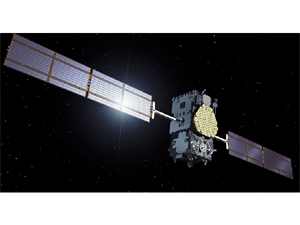



Date:27/12/17
 The European Space Agency's next miniature satellite will be the first capable of shifting its orbit thanks to tiny butane-powered thrusters.
The European Space Agency's next miniature satellite will be the first capable of shifting its orbit thanks to tiny butane-powered thrusters.
GomX-4B is made of six CubeSats, the standard nanosatellite. Together, they form the shape of a large cereal box. Because CubeSats are relatively cheap to build, scientists are increasingly using the mini spacecraft to test new technologies in space.
GomX-4B is one of a pair. The twins, GomX-4A and GomX-4B, will be launched from China in February. Danish company GomSpace built the two satellites.
"The two CubeSats will test intersatellite link technology, routing data from one satellite to the other, then down to the ground station," Roger Walker, head of ESA's Technology CubeSat initiative, said earlier this year. "Part of the ground testing ensured they could indeed talk to each other and the actual ground station on an end-to-end basis."
In addition to testing miniaturized communications technology, GomX-4B will demonstrate the potential of its novel nanothrusters. Swedish company NanoSpace designed the thrusters.
A pair of fuel tanks will provide the two thrusters with butane. But the thrusters won't burn propellant, they will only create a phase change. Engineers suggest the 'cold-gas' thrusters are the cheapest, safest bet for small missions like this.
"The fuel is stored under pressure, then released through a tiny rocket nozzle. Even though it's cold gas, we achieve a substantial velocity change by using liquid butane that turns to gas as it exits," Tor-Arne Grönland, head of NanoSpace, said in an ESA update this week. "Storing it as a liquid, like in a cigarette lighter, allows us to pack as many butane molecules as possible inside the small available volume -- its liquid form being some 1,000 times denser than its gas."
Each thruster will produce just a single millinewton of force. But over time, such a thrust will be enough to alter the mini satellite's orbit.
NanoSpace first tested its thruster technology on China's TW-1 satellite in 2015. The new ESA mission, however, will offer a chance to test the technology in new ways.
"We'll do different kinds of burns: long, short, pulsing and throttling up and down," Grönland said. "It's important to do these things early in the mission then again late on, to show it can survive and perform well in space."
ESA’s butane-powered satellite will be able to change its orbit
 The European Space Agency's next miniature satellite will be the first capable of shifting its orbit thanks to tiny butane-powered thrusters.
The European Space Agency's next miniature satellite will be the first capable of shifting its orbit thanks to tiny butane-powered thrusters.GomX-4B is made of six CubeSats, the standard nanosatellite. Together, they form the shape of a large cereal box. Because CubeSats are relatively cheap to build, scientists are increasingly using the mini spacecraft to test new technologies in space.
GomX-4B is one of a pair. The twins, GomX-4A and GomX-4B, will be launched from China in February. Danish company GomSpace built the two satellites.
"The two CubeSats will test intersatellite link technology, routing data from one satellite to the other, then down to the ground station," Roger Walker, head of ESA's Technology CubeSat initiative, said earlier this year. "Part of the ground testing ensured they could indeed talk to each other and the actual ground station on an end-to-end basis."
In addition to testing miniaturized communications technology, GomX-4B will demonstrate the potential of its novel nanothrusters. Swedish company NanoSpace designed the thrusters.
A pair of fuel tanks will provide the two thrusters with butane. But the thrusters won't burn propellant, they will only create a phase change. Engineers suggest the 'cold-gas' thrusters are the cheapest, safest bet for small missions like this.
"The fuel is stored under pressure, then released through a tiny rocket nozzle. Even though it's cold gas, we achieve a substantial velocity change by using liquid butane that turns to gas as it exits," Tor-Arne Grönland, head of NanoSpace, said in an ESA update this week. "Storing it as a liquid, like in a cigarette lighter, allows us to pack as many butane molecules as possible inside the small available volume -- its liquid form being some 1,000 times denser than its gas."
Each thruster will produce just a single millinewton of force. But over time, such a thrust will be enough to alter the mini satellite's orbit.
NanoSpace first tested its thruster technology on China's TW-1 satellite in 2015. The new ESA mission, however, will offer a chance to test the technology in new ways.
"We'll do different kinds of burns: long, short, pulsing and throttling up and down," Grönland said. "It's important to do these things early in the mission then again late on, to show it can survive and perform well in space."
Views: 498
©ictnews.az. All rights reserved.Similar news
- Azerbaijani project to monitor disease via mobile phones
- Innovative educational system to be improved under presidential decree
- NTRC prolongs license of two TV and radio organizations for 6 years
- Azerbaijan establishes e-registry for medicines
- Azerbaijani museum introduces e-guide
- Nar Mobile opens “Nar Dunyasi” sales and service center in Siyazan city
- International conference on custom electronic services held in Baku
- OIC secretary general to attend COMSTECH meeting in Baku
- Azerbaijan develops earthquake warning system
- New law to regulate transition to digital broadcasting in Azerbaijan
- Azerbaijani State Social Protection Fund introduces electronic digital signature
- Intellectual traffic management system in Baku to be commissioned in December
- Tax Ministry of Azerbaijan started receiving video-addresses
- World Bank recommends Azerbaijan to speed up e-service introduction in real estate
- Azerbaijan to shift to electronic registration of real estate





















